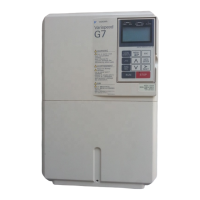7-6
Motor Overload
The motor overload protection func-
tion has operated based on the internal
electronic thermal value.
The directions of the motor and PG
are different. (Only in flux vector con-
trol)
• Correct the PG wiring.
• Correct the motor wiring.
• Change the setting of PG rota-
tion (F1-05).
The V/f characteristics voltage is too
high or too low.
Check the V/f characteristics.
The Motor Rated Current (E2-01) and
Motor 2 Rated Current (E4-01) is
incorrect.
Check the Motor Rated Current
(E2-01) and Motor 2 Rated Cur-
rent (E4-01).
• A short-circuit between +V, −V, and
AC terminals occurred.
• Overload in the control circuit ter-
minal.
• Make sure that incorrect wiring
has not been done.
• Check the resistance and wir-
ing for the frequency setting
potentiometer, etc. (Check that
the current for terminals +V and
–V is 20 mA or less.)
Inverter Overload
The Inverter overload protection func-
tion has operated based on the internal
electronic thermal value.
The load is too heavy. The accelera-
tion time, deceleration time and cycle
time are too short.
Check the size of the load and the
length of the acceleration, deceler-
ation, and cycle times.
The constant setting for speed search
is incorrect.
(Motor overload occurred due to
motor hunting and vibration.)
• Use the speed search function.
• Adjust the settings of the Speed
search operating current (b3-02)
and Speed search deceleration
time (b3-03).
• Use the estimated speed search
function. (Perform stationary
autotuning for line-to-line resis-
tance only.)
The directions of the motor and PG
are different. (Only in flux vector con-
trol)
• Correct the PG wiring.
• Correct the motor wiring.
• Change the setting of PG rota-
tion (F1-05).
The V/f characteristics voltage is too
high or too low.
Check the V/f characteristics.
The Inverter capacity is too low.
Replace the Inverter with one that
has a larger capacity.
• A short-circuit between +V, −V, and
AC terminals occurred.
• Overload in the control circuit ter-
minal.
• Make sure that incorrect wiring
has not been done.
• Check the resistance and wir-
ing for the frequency setting
potentiometer, etc. (Check that
the current for terminals +V and
–V is 20 mA or less.)
Inverter overload occurred when run-
ning at a low speed of 6 Hz or less.
• Reduce the load.
• Increase the frame size of the
Inverter.
• Lower the carrier frequency.
Overtorque Detected 1
There has been a current greater than
the setting in L6-02 for longer than the
setting in L6-03.
-
• Make sure that the settings in
L6-02 and L6-03 are appropri-
ate.
• Check the mechanical system
and correct the cause of the
overtorque.
Table 7.1 Fault Displays and Processing (Continued)
Display Meaning Probable Causes Corrective Actions

